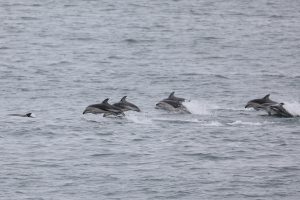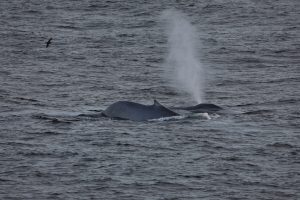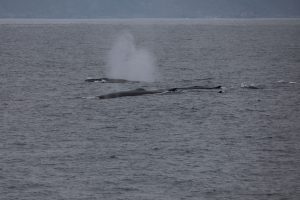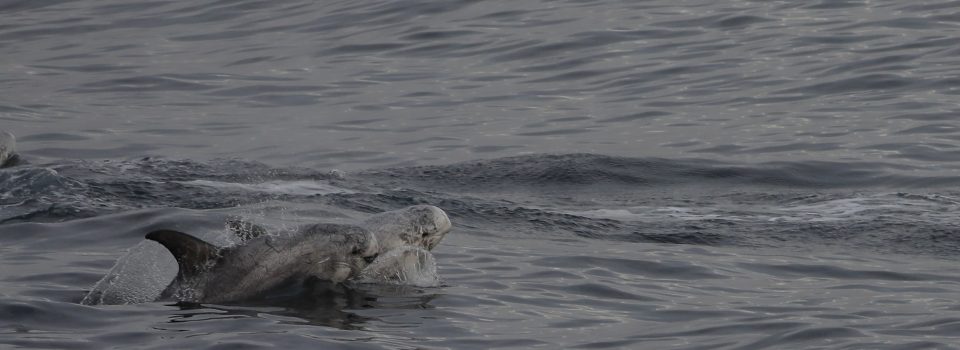Chilean study on marine cetaceans causes worldwide impact
November 4th, 2022 Marine cetaceans abundance and distribution patterns in Chile and their overlap with ship traffic in the Humboldt Current ecosystem are published at Scientific Report. prestigious scientific journal
Marine cetaceans abundance and distribution patterns in Chile and their overlap with ship traffic in the Humboldt Current ecosystem are published at Scientific Report. prestigious scientific journal
Aiming in improving knowledge gaps on Chilean waters cetaceans, in 2016, Monitoring of Highly Migratory Resources – Ecosystemic Approach (SRAM ECO) project directed by Dr. Patricia Zárate, began to carry out cetaceans sighting activity in chilean exclusive economic zone. Aboard some oceanographic and hydroacoustic cruises regularly carried out by IFOPś Direct Assessments Department of (DED) and Oceanography and Environment Department (DOMA) on board the R/C Abate Molina.
Using 2016-2021 collected data through linear transects between 18°S and 41°S and up to about 200 km offshore, the team of researchers led by Dr. Luis Bedriñana from Marine Sciences and Limnologicas Institute from Universidad Austral de Chile published on June 24th the first abundance and distribution estimates for fin whale (Balaenoptera physalus), southeast Pacific blue whale (Balaenoptera musculus), sperm whale (Physeter macrocephalus), dolphin dusky (Lagenorhynchus obscurus) and common dolphin (Delphinus spp.) throughout the Chilean portion of the Humboldt Current.
 Dr. Patricia Zarate explained “In 2016, we started the whale watching activity with only 1 scientific observer, but later, through training and education, we were able to count on trained and experienced personnel to continue this activity. The results of these 7 consecutive years of data have borne fruit and today we can count on valuable information on the distribution and abundance of species that play relevant ecological roles in the ecosystem, but are also threatened by anthropogenic activities in the Pacific Ocean. and in our Exclusive Economic Zone”.
Dr. Patricia Zarate explained “In 2016, we started the whale watching activity with only 1 scientific observer, but later, through training and education, we were able to count on trained and experienced personnel to continue this activity. The results of these 7 consecutive years of data have borne fruit and today we can count on valuable information on the distribution and abundance of species that play relevant ecological roles in the ecosystem, but are also threatened by anthropogenic activities in the Pacific Ocean. and in our Exclusive Economic Zone”.
Dr. Luis Bedriñana added “The work presents for the first time in Chile distribution and abundance estimates on 5 cetaceans species in the entire Chilean portion of the Humboldt Current. It synthesizes two great efforts in Chile. On one hand, the effort of Fisheries Development Institute to build a program of these characteristics from scratch and that finds in this publication one of its first achievements. On the other hand, it is very important to highlight SERNAPESCA effort , which since 2020 has provided daily updated information on navigation routes of 4 fleets in Chile publicly and free of charge. This is something very valuable and where we must continue advancing in terms of transparency and accessibility to information that helps research for conservation”.
Robert Bello, who has served as Principal Scientific Observer of the cetacean sighting activity since 2016 and to date, added: “Perhaps the most challenging thing in the activities as an observer at the Institute has been transforming sighting data, what at first seemed like a splash or shadows in the distance in the immensity of the sea, in events that often only lasted a few seconds. Being part of the team that makes one of the first contributions to studies of population abundance of cetaceans in the region is a great joy personally and, I believe, a great achievement as an observer. Adapting the linear transect methodology to the cruises carried out annually by the IFOP was a challenging but demanding task and if it was quickly achieved it was thanks to the contribution of the scientific observers who were part of this activity. I only hope that this continues and more people continue to be trained to develop this activity”
 Ilia Cari, SRAM ECO project researcher pointed out “One aspect that has been a key issue to continue with this program is thanks to cruise chiefs’s different fishery resource assessment projects within the Institute good disposition in which has managed to carry out sighting activity. Having their support is essential to give continuity to the program in the future and to be able to assess population trends, as well as associate these cetaceans presence with the environmental variables measured in situ through the same cruises, which will help to have a best idea of the environmental preferences of these species”.
Ilia Cari, SRAM ECO project researcher pointed out “One aspect that has been a key issue to continue with this program is thanks to cruise chiefs’s different fishery resource assessment projects within the Institute good disposition in which has managed to carry out sighting activity. Having their support is essential to give continuity to the program in the future and to be able to assess population trends, as well as associate these cetaceans presence with the environmental variables measured in situ through the same cruises, which will help to have a best idea of the environmental preferences of these species”.
Dr. Bedriñana expressed “Something very valuable to highlight from this work is that very few countries, and much less in Latin America, have the capacity to systematically monitor cetacean populations in such a large area and for 7 consecutive years. If the program continues and is strengthened, we will soon be able to know if the populations are increasing or not and how fast, this being one of the most important questions to answer for any species conservation. In addition, this work also evaluated the degree of overlap between cetaceans and boats distribution, finding that artisanal and industrial fishing fleets have a high overlap with fin whale and the dusky dolphin distribution in particular”.
Ljubitza Clavijo investigated added “Seeing results reflected in a scientific article fills me with satisfaction, since the interaction with my colleagues allowed me to improve my skills and grow as a professional. A job of this magnitude requires continuous effort and a great deal of time, since it involves, among other things, training different observers to achieve the detail that we appreciate, the active participation of the coordinators of the Management and Sampling Department, and the validation of the data before the analysis can be carried out.
“To assess cetacean populations potential risk, it is key to identify and understand effects caused by cumulative human impacts and thus establish effective protection and management measures. Many species of cetaceans are vulnerable to incidental fishing, and this study continuation will also allow indicators development to estimate sustainable levels of mortality of those species that are captured incidentally in Chilean fisheries, which may serve as a basis for the development of conservation measures for these species in our country” concluded Dr. Patricia Zárate.
Links to view the publication
https://www.nature.com/articles/s41598-022-14465-7
